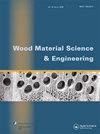竹-钢-竹螺栓连接竹材连接节点承载性能试验研究
IF 2.1
3区 农林科学
Q1 MATERIALS SCIENCE, PAPER & WOOD
引用次数: 3
摘要
摘要在本研究中,共设计了四十二个节点试件,以探索螺栓竹钢竹连接在轴向拉伸下的性能。选择关键设计参数作为变量,包括螺栓端部距离、直径和数量。从螺栓和接头两个方面分析了失效模式和力学性能。最后,在木结构螺栓连接承载力计算公式的基础上,考虑螺栓直径和螺栓数量的影响,提出了试验竹木连接节点的承载力设计方法。试验结果表明,接头失效主要受竹纤维承载力和螺栓弯曲的控制。在设计范围内,螺栓端距对节点承载力的影响可以忽略不计。接头的承载能力随着螺栓直径的增加而增加。对于单列螺栓连接,接头的承载力随着螺栓数量的增加而增加。中国设计规范中的单螺栓承载力修正公式和欧洲木结构设计规范中多螺栓承载力的修正公式与试验结果吻合较好。本文章由计算机程序翻译,如有差异,请以英文原文为准。
Experimental investigations on the bearing properties of bamboo scrimber joints by a bolted bamboo-steel-bamboo connection
ABSTRACT In this study, a total of forty-two joint specimens were designed to explore the properties of the bolted bamboo-steel-bamboo connection under axial tension. Key design parameters were selected as variables, including the bolt end distance, diameter, and number. Failure modes and mechanical properties were analyzed from the aspects of both bolts and joints. Finally, modified from calculation formula for the bearing capacity of bolted joints in wood structures, the design method for the tested bamboo scrimber connection joint was proposed for the bearing capacity while considering the influence of bolt diameter and bolt number. According to the experimental results, the joint failure was mainly controlled by the bamboo scrimber bearing capacity and bolt bending. Within the design scope, the influence of bolt end distance on the bearing capacity of the joint can be ignored. The bearing capacity of the joint increases with the increase of the bolt diameter. For single-row bolt connection, the bearing capacity of the joint increases with the increase of the number of bolts. The modified formula of single-bolt bearing capacity in the Chinese design codes and multi-bolt bearing capacity in the European code for design of wood structures are in best agreement with the test results.
求助全文
通过发布文献求助,成功后即可免费获取论文全文。
去求助
来源期刊

Wood Material Science & Engineering
Materials Science-General Materials Science
CiteScore
3.90
自引率
13.60%
发文量
131
审稿时长
79 days
期刊介绍:
Wood Material Science and Engineering is a multidisciplinary and international journal with the aim to serve at the forefront of the wood science and technology field. The journal publishes original articles on basic and applied research dealing with:
-Wood material science with emphasis on: water-wood relations, wood durability, wood modification, wood mechanics, wood composites, engineered wood products, energy conversion and eco-efficient wood based products.
-Wood engineering, i.e. the application of the wood material science to designing, processing and manufacturing of forest products and the use of machines and processes for these products. Products of concern are biofuels, sawn wood and further refined products such as structural elements, interior fittings and furnishings. In this aspect the link between the nature of the wood material and the properties of the final wood products in-service and its impact on the environment is of outmost importance.
High quality review papers may also be accepted but the topic should be discussed with the editor before submission.
 求助内容:
求助内容: 应助结果提醒方式:
应助结果提醒方式:


